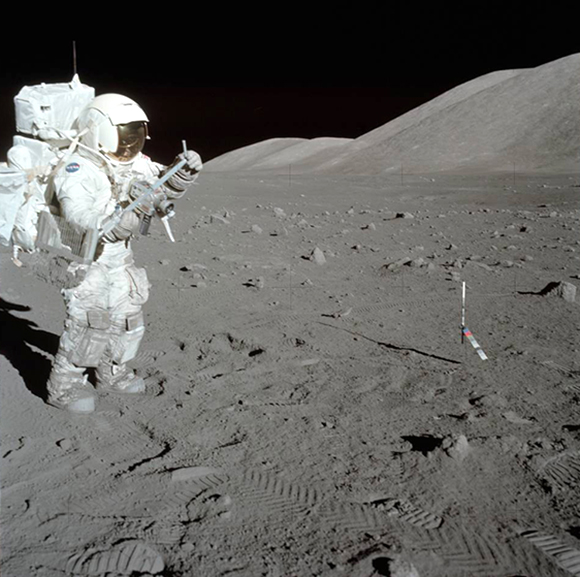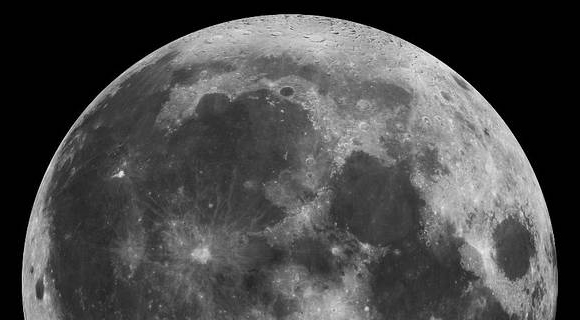NASA Selects Nine Teams To Study Moon Samples Untouched For Nearly 50 Years
By NASA // March 11, 2019
total of $8 million awarded to the teams

(NASA) – NASA has selected nine teams to continue the science legacy of the Apollo missions by studying pieces of the Moon that have been carefully stored an untouched for nearly 50 years.
A total of $8 million has been awarded to the teams.
“By studying these precious lunar samples for the first time, a new generation of scientists will help advance our understanding of our lunar neighbor and prepare for the next era of exploration of the Moon and beyond, “ said Thomas Zurbuchen, Associate Administrator for NASA’s Science Mission Directorate in Washington, DC.
“This exploration will bring with it new and unique samples into the best labs right here on Earth.”
Six of the nine teams will look at one of the three remaining lunar samples, from Apollo missions 15, 16, and 17, which have never been exposed to Earth’s atmosphere.
The particular sample these teams will study came to Earth vacuum-sealed on the Moon by the Apollo 17 astronauts Harrison Schmitt and Gene Cernan in 1972.
The Apollo 17 sample comprises about 800 grams (1.8 pounds) of material, still encased in a “drive tube” that was pounded into the lunar regolith to collect a core of material. That core preserves not just the rocks themselves but also the stratigraphy from below the surface so today’s scientists can, in a laboratory, study the rock layers exactly as they existed on the Moon. The core has been carefully stored at NASA’s Johnson Space Center in Houston, Texas, since December 1972.

Other teams will be studying samples that have also been specially curated, some from Apollo 17 that were brought to Earth and then kept frozen, and samples from the Apollo 15 mission which have been stored in helium since 1971.
NASA has only collected samples from a few places on the Moon so far, but NASA knows from the remote sensing data that the Moon is a complex geologic body. From orbit, the agency has identified types of rocks and minerals that are not present in the Apollo sample collection.
“Returned samples are an investment in the future. These samples were deliberately saved so we can take advantage of today’s more advanced and sophisticated technology to answer questions we didn’t know we needed to ask,” said Lori Glaze, acting director of NASA’s Planetary Science Division in Washington, DC.
The nine institutions include:
NASA Ames Research Center/Bay Area Environmental Research Institute: A team led by Alexander Sehlke will complete an experiment started 50 years ago by studying the frozen lunar samples from Apollo 17 to see how volatiles like water are stored in the radiation environment of the lunar surface, which is not protected by an atmosphere like Earth.
NASA Ames – A team led by David Blake and Richard Walrothwill study the vacuum-sealed sample to study “space weathering” or how exposure to the space environment affects the Moon’s surface.
NASA’s Goddard Spaceflight Center: A team led by Jamie Elsila Cook will study the vacuumed-sealed sample to better understand how small organic molecules—namely, precursors to amino acids—are preserved on the Moon.
NASA Goddard: A team led by Barbara Cohen and Natalie Curren will study the vacuum-sealed sample to investigate the geologic history of the Apollo 17 site. They’ll specifically be looking at the abundance of noble gases in the sample, which can tell them about the sample’s age.
University of Arizona: A team led by Jessica Barneswill study how curation affects the amount of hydrogen-bearing minerals in lunar soil, which will help us better understand how water is locked in minerals on the Moon.
University of California Berkeley: A team led by Kees Welten will study how micrometeorite and meteorite impacts may have affected the geology of the lunar surface.
US Naval Research Laboratory: A team led by Katherine Burgess will look at the frozen samples and the samples stored in helium to study how airless bodies are affected by exposure to the space environment.
University of New Mexico: A team led by Chip Shearer will look at the vacuum-sealed sample to study the geologic history of the Apollo 17 site. They will be studying samples from a region that had been cold enough for water to freeze—called a “cold trap.” This will be the first time a sample from one of these cold traps will be examined in the lab.
Mount Holyoke College/Planetary Science Institute: A team led by Darby Dyer will look at both the vacuum-sealed samples and samples stored on helium to study volcanic activity on the Moon. They’ll specifically look at tiny glass beads that formed rapidly during an ancient lunar eruption.
The samples won’t be opened right away. First, the teams will work together and with the curation staff at NASA Johnson to determine the best way to open the sample to avoid contaminating them and maximize the science to be gained.
The teams for the Apollo Next-Generation Sample Analysis grants were selected by the Planetary Science Division and will be funded by the Lunar Discovery and Exploration Program.
CLICK HERE FOR BREVARD COUNTY NEWS














